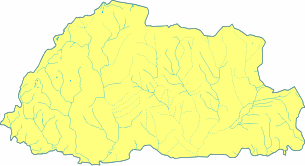Daga Province
Daga Province (Dzongkha: དར་དཀར་; Wylie: dar-dkar) was one of the nine historical Provinces of Bhutan.[1]
Daga Province occupied lands in west-central Bhutan. It was administered from the town of Daga. The ruling governor was known as the Penlop of Daga, or Dagab. Real power, however, rested in the hands of the Penlop of Paro, the dominant lord of western Bhutan.[1][2]: 203 [3]: 141
History
Under Bhutan's early theocratic dual system of government, decreasingly effective central government control resulted in the de facto disintegration of the office of Shabdrung after the death of Shabdrung Ngawang Namgyal in 1651. Under this system, the Shabdrung reigned over the temporal Druk Desi and religious Je Khenpo. Two successor Shabdrungs – the son (1651) and stepbrother (1680) of Ngawang Namgyal – were effectively controlled by the Druk Desi and Je Khenpo until power was further splintered through the innovation of multiple Shabdrung incarnations, reflecting speech, mind, and body. Increasingly secular regional lords (penlops and dzongpons) competed for power amid a backdrop of civil war over the Shabdrung and invasions from Tibet, and the Mongol Empire.[4] The penlops of Trongsa and Paro, and the dzongpons of Punakha, Thimphu, and Wangdue Phodrang were particularly notable figures in the competition for regional dominance.[4][5] During this period, there were a total of nine provinces and eight penlops vying for power.[6]
Traditionally, Bhutan comprised nine provinces: Trongsa, Paro, Punakha, Wangdue Phodrang, Daga (also Taka, Tarka, or Taga), Bumthang, Thimphu, Kurtoed (also Kurtoi, Kuru-tod), and Kurmaed (or Kurme, Kuru-mad). The Provinces of Kurtoed and Kurmaed were combined into one local administration, leaving the traditional number of governors at eight. While some lords were Penlops, others held the title Dzongpen (Dzongkha: རྗོང་དཔོན་; Wylie: rjong-dpon; also "Jongpen," "Dzongpön"); both titles may be translated as "governor."[1]
The 10th Penlop of Trongsa Jigme Namgyel (r. 1853–1870) began consolidating power, paving the way for his son the 12th Penlop of Trongsa (and 21st Penlop of Paro) Ugyen Wangchuck to prevail in battle against all rival penlops and establish the monarchy in 1907. With the establishment of the monarchy and consolidation of power, the traditional roles of provinces, their rulers, and the dual system of government came to an end.[7][8]
See also
References
- ^ a b c Madan, P. L. (2004). Tibet, Saga of Indian Explorers (1864–1894). Manohar Publishers & Distributors. pp. 77 et seq. ISBN 978-81-7304-567-7. Retrieved 2011-08-14.
- ^ Dorji, C. T. (1994). "Appendix III". History of Bhutan based on Buddhism. Sangay Xam, Prominent Publishers. p. 200. ISBN 978-81-86239-01-8. Retrieved 2011-08-12.
- ^
 This article incorporates text from this source, which is in the public domain: White, J. Claude (1909). Sikhim & Bhutan: Twenty-One Years on the North-East Frontier, 1887–1908. New York: Longmans, Green & Co. pp. 11, 272–3, 301–10. ISBN 9780598739278. Retrieved 2010-12-25.
This article incorporates text from this source, which is in the public domain: White, J. Claude (1909). Sikhim & Bhutan: Twenty-One Years on the North-East Frontier, 1887–1908. New York: Longmans, Green & Co. pp. 11, 272–3, 301–10. ISBN 9780598739278. Retrieved 2010-12-25.
- ^ a b
 This article incorporates text from this source, which is in the public domain. Worden, Robert L. (September 1991). Savada, Andrea Matles (ed.). Bhutan: A Country Study. Federal Research Division. Administrative Integration and Conflict with Tibet, 1651–1728.
This article incorporates text from this source, which is in the public domain. Worden, Robert L. (September 1991). Savada, Andrea Matles (ed.). Bhutan: A Country Study. Federal Research Division. Administrative Integration and Conflict with Tibet, 1651–1728.
- ^
 This article incorporates text from this source, which is in the public domain. Worden, Robert L. (September 1991). Savada, Andrea Matles (ed.). Bhutan: A Country Study. Federal Research Division. Civil Conflict, 1728–72.
This article incorporates text from this source, which is in the public domain. Worden, Robert L. (September 1991). Savada, Andrea Matles (ed.). Bhutan: A Country Study. Federal Research Division. Civil Conflict, 1728–72.
- ^ Lawrence John Lumley Dundas Zetland (Marquis of); Ronaldsha E., Asian Educational Services (2000). Lands of the Thunderbolt: Sikhim, Chumbi & Bhutan. Asian Educational Services. p. 204. ISBN 978-81-206-1504-5. Retrieved 2011-08-10.
- ^ Padma-gliṅ-pa (Gter-ston); Harding, Sarah (2003). Harding, Sarah (ed.). The life and revelations of Pema Lingpa. Snow Lion Publications. p. 24. ISBN 978-1-55939-194-8. Retrieved 2011-08-10.
- ^ Brown, Lindsay; Mayhew, Bradley; Armington, Stan; Whitecross, Richard W. (2007). Bhutan. Lonely Planet Country Guides (3 ed.). Lonely Planet. pp. 38–43. ISBN 978-1-74059-529-2. Retrieved 2011-08-09.

